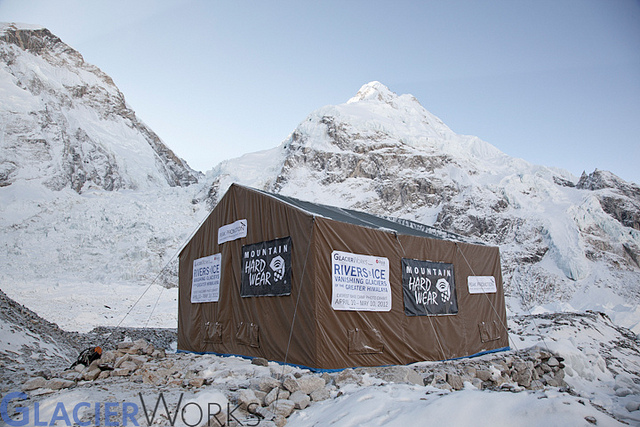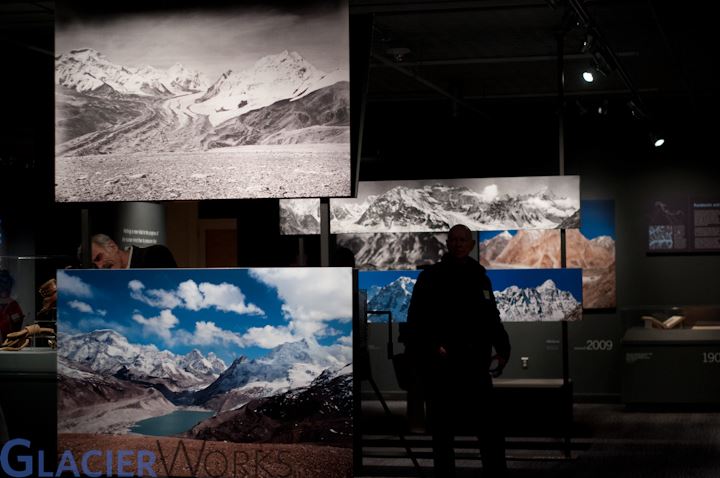Rivers of Ice: Exhibitions at MIT Museum and Everest Base Camp
An exhibition at the Mount Everest Base Camp is no ordinary undertaking. The location itself is bound to generate a few shudders. But for an organization named GlacierWorks, no glacier is too remote a location to increase awareness about the potential impact of glacial loss on Asia’s water supply. Incidentally, for those far from the Himalayas but close to Massachusetts, their work is also being exhibited at the MIT Museum. GlacierWorks is an organization we have written about in the past because of their unique use of “art, science, and adventure” to document changes in the Himalayan glaciers. Through a process of matched photography, using images by 20th century photographers such as Vittorio Sella and Sir George Mallory, they are able to note the decrease in glacial mass that has taken place during the course of the century. The results are presented in compelling photographic exhibitions that narrate a story of loss in the highest reaches of the Himalayas.
MIT Museum. GlacierWorks is an organization we have written about in the past because of their unique use of “art, science, and adventure” to document changes in the Himalayan glaciers. Through a process of matched photography, using images by 20th century photographers such as Vittorio Sella and Sir George Mallory, they are able to note the decrease in glacial mass that has taken place during the course of the century. The results are presented in compelling photographic exhibitions that narrate a story of loss in the highest reaches of the Himalayas.
For an exhibition titled, Rivers of Ice: Vanishing Glaciers of the Greater Himalaya, the Everest Base Camp couldn’t be a more appropriate or beautiful location. “Set against the magnificent backdrop of Mount Everest and the Khumbu glacier, Rivers of Ice presents visitors with a chance to admire the vast beauty of the High Himalaya while reflecting upon the profound changes taking place in this seemingly impermeable landscape.”
GlacierWorks stresses how some of the most important rivers in Asia (Indus, Ganges, Yellow, Yangtze etc.) rely on the Himalayan glaciers for “seasonal flow of fresh water”, and any change in that flow can affect millions of people downstream.
“Data collection in this vast and remote region is impossible for all but the most seasoned climbers, and each glacier has unique characteristics that prevent broad generalizations about the region as a whole. Nevertheless, scientists agree that there is a trend of melting beyond what can be expected to occur naturally.”
Since Everest Base Camp is a mountaineering mecca of sorts, Rivers of Ice is sure to affect the daring mountaineers who tread upon the very glaciers exhibited. Yet more importantly, the cause for concern is destined to wind its way down the Himalayas; to India, China, and the international community as a whole. Those with little to no inclination for steep inclines and frosty conditions can keep up with the exhibit via GlacierWorks’ Facebook and Google+ pages. You can also follow the exhibit on their Twitter, where it will be promoted using the hashtag, #icegallery.
If you wish to see their photographs in person but are daunted by the notion of a journey to the base of Mount Everest, you can make a far less taxing visit to the Rivers of Ice exhibit at the MIT Museum. Rivers of Ice seeks to “trigger public dialogue as scientists and policymakers work to better understand the glaciers’ potential impact on the fresh water supply in Asia, and on global environmental issues in general.”
As the MIT Museum explains, the true plight of the Himalayan glaciers has led to a certain degree of controversy in academia. A scientific report earlier this year concluded that the Himalayan glaciers had in effect seen no decrease in ice between 2003 and 2010; the loss of glacial ice had been compensated for by an increase in ice in the caps. Understandably, the behavior of these glaciers confounds climate scientists. Yet they remain a rare, unexplained exception as the study shows that glaciers in Antarctica and Greenland are losing mass at significant rates. Globally, a total of 536 gigatonnes of ice have been lost between 2003 and 2010.
The MIT Museum goes on to say the following:
“As our thinking about Rivers of Ice evolved, we came to realize that the exhibition gives us an ideal platform for opening discussions about climate change, about water resources and, fundamentally, about how science works. Acquiring scientific knowledge is a back-and-forth, trial and error process. As the research continues, we hope for more clarity, but we're prepared for more disagreement about what exactly is happening to the glaciers in the Himalaya.”
GlacierWorks photographs are an excellent opportunity to delve into the conversation about climate change. And even as we wait upon clarity regarding the Himalayan glaciers, the broader trend of glacial loss could not be clearer. It’s easy to forget about climate change when you live under perpetually sunny skies. But a trip to the Himalayan glaciers on GlacierWork’s website or the MIT Museum will definitely give you something to shiver about.

